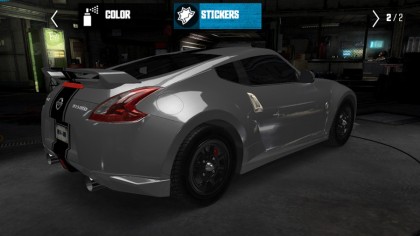One of the worst of these takes place right at the beginning of the game, when you're introduced to raid spec cars, the game's most rugged vehicle configuration, for a Takedown mission that requires you to ram an AI driver into submission.
Your efforts will be thwarted until you realise that your target moves along the same route every time and only slows down enough for you to make contact at predefined moments. Clearly you're supposed to use your nitrous boost to close the gap, but it's ineffective unless the moment you open the valve coincides with a contraction of that invisible rubber band. Even then, you'll make an infuriatingly small dent in your opposition's health bar.
Getaway events reverse the places of cat and mouse and set you on the run from aggressive police or gang cars. You'll find yourself just as outmatched, your pursuers able to close huge gaps with uncanny bursts of speed and to come to a halt in an instant.
When they do it right in front of you, you'll stop too, triggering a short countdown to your arrest, which usually leaves you too little time to reverse away. You can always ram police and gang cars, but doing so is a considerable risk given that their health bars are nearly as robust as Takedown targets, and how easily they can bring you to a halt.
But more frustrating is the way that new pursuers will often spawn in front of you just as you've broken free of the pack, plunging you back into the chase. And while the game assimilates much of Ubisoft's familiar open-world template – not least the need to find Data Stations in order to reveal missions and locations in an area – it fails to borrow Watch Dogs' ability to hide from helicopters under bridges or in tunnels.

Creative touches
All that said, missions at least feel handcrafted. Set-piece events punctuate races, whether it's simply a crop duster flying overhead or something dramatic, such as an avalanche. And some events exhibit a burst of creativity, such as a race that places you in a dirt spec car and tasks you with beating a much faster street car by taking advantage of off-road shortcuts.
Mostly, however, story missions are unsatisfying and even the best ones still subject you to the game's unpredictable collision detection; a head-on crash with oncoming traffic will be brushed off one minute, before the merest contact with a verge sends your car cartwheeling across the ground in an unskippable slow-mo crash cut-scene. Holding the reset button will return you to the track a little way back from your calamity, but should your AI opponents suffer any such indignity, they're granted a respawn farther up the road.
Sign up for breaking news, reviews, opinion, top tech deals, and more.
Such unsporting design is enough to make you want to put as many miles between you and the campaign as possible. Thankfully, in a game that also features a condensed North America to explore, that's entirely possible.
And for all The Crew's misfiring components, almost everything is pushed to the back of your mind once you're out on the open road with a friend or three as you make your way from New York to Los Angeles while the sun dips over the horizon. This distilled US is a remarkable achievement that packs in lots of road trip destinations worth fantasising about, including many major cities, Route 66 and Yosemite National Park. But it's the unexpected discoveries you'll make along the way that thrill: a giant model of a cow, a colossal crater, or the Morning Glory Pool in Yellowstone.
Roam if you want to
Discovering landmarks such as these will pull you off the planned route regularly, as geographical features, or the distant light from a small town at dusk, pique your interest. What's more, regions feel distinct as you pass through them, the lighting, colour scheme and even traffic (what little of it there is) subtly changing to reflect each state's makeup and biome. Exploring such a vast map so packed full of character is a pleasure.
But even these gains are undermined by the argumentative camera, by pop-in, and by jarring aliasing issues. There's so much to see and yet the camera remains steadfastly locked on a horizontal plane, so anything taller than a storey is impossible to view unless you're hundreds of metres from it. Landmark icons are situated by most locations of note, which offer a few sweeping views of the area in question when activated, but they're a poor substitute for an in-game camera that points where you ask it to.
Perhaps its omission was a deliberate attempt to stop you examining the muddy textures too closely. While moments of genuine beauty exist, they occur in the context of a game that otherwise simply cannot compete with its contemporaries when it comes to visual presentation – a symptom, perhaps, of the seven-year development cycle. It's in stark contrast to that crisp introductory sequence. If you finish the main campaign, it even plays again, serving as a reminder of what The Crew might have been if only it were assembled with the same attention to detail.
Current page: Takedown troubles
Prev Page The Crew Next Page Interview with Design Director Stephane Beley